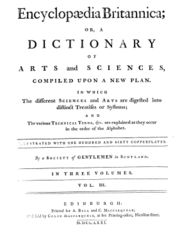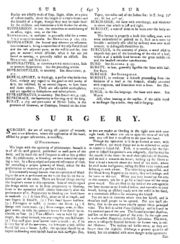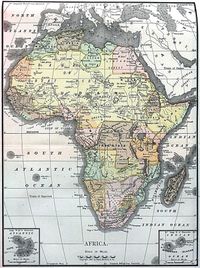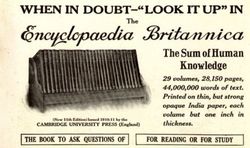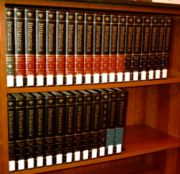Encyclopædia Britannica
2007 Schools Wikipedia Selection. Related subjects: General Literature
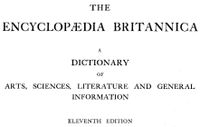 |
|
| Introduction to the Eleventh Edition | |
| Author | Many |
|---|---|
| Translator | None |
| Country | Scotland, England, now United States |
| Language | English |
| Subject(s) | General |
| Genre(s) | Reference encyclopedia |
| Publisher | Encyclopædia Britannica Inc. |
| Released | 1768 |
| Media Type | Series of Hardback Volumes |
The Encyclopædia Britannica (properly spelled with the æ ligature) is a general encyclopedia published by the privately held Encyclopædia Britannica Inc.. Regarded as one of the most important and widely recognized reference works in the English language, the encylopedia was first published progressively from 1768–71 as Encyclopædia Britannica, or, A dictionary of arts and sciences, compiled upon a new plan. It was one of the first printed English encyclopedias and today is the oldest continuously published English-language encyclopedia in the world.
From the late 18th century to the early 20th century, Britannica's articles were often judged as the foremost authority on a topic, and sometimes included new research or theory intended for a scholarly audience. During this era, the Britannica gained its erudite reputation and had a unique position in English-speaking culture.
The Britannica has survived fierce competition from an ever-increasing number of alternative information sources. New reference sources, such as academic journals, textbooks, specialized publications, and electronic resources, have redefined the demand for the print encyclopedia; although a print edition is still available, the Britannica has evolved primarily into electronic versions on CD-ROM, DVD and the World Wide Web.
History
A product of the Scottish Enlightenment, the Britannica was originally published in late 1768 in Edinburgh and was the idea of Colin Macfarquhar, a bookseller and printer, and Andrew Bell, an engraver, who published the reference work under the pseudonym "Society of Gentlemen." Needing an editor, the two chose a 28-year-old scholar named William Smellie who was offered 200 pounds sterling to produce the encyclopedia in 100 parts and three volumes. The first part appeared in December 1768, priced sixpence. By 1771, Britannica was complete, with 2,391 pages and 160 engraved illustrations; an estimated 3,000 copies had been sold. It consisted of three equally sized volumes covering A–B, C–L, and M–Z.
| It was compiled, as the title-page says, on a new plan. The different sciences and arts were "digested into distinct treatises or systems," of which there are 45 with cross headings, that is, titles printed across the page, and about 30 other articles more than three pages long. The longest are "Anatomy," 166 pages, and "Surgery," 238 pages. "The various technical terms, etc., are explained as they occur in the order of the alphabet." "Instead of dismembering the sciences, by attempting to treat them intelligibly under a multitude of technical terms, they have digested the principles of every science in the form of systems or distinct treatises, and explained the terms as they occur in the order of the alphabet, with references to the sciences to which they belong." This plan, as the compilers say, differs from that of all the previous dictionaries of arts and sciences. Its merit and novelty consist in… on the one hand keeping important subjects together, and on the other facilitating reference by numerous separate articles. |
After the success of the first edition, a more ambitious second edition followed, with the addition of history and biography articles. This time around Smellie declined to be editor. Macfarquhar took over the role himself, aided by a dilettante named James Tytler. The second edition was published 1777–84 in ten volumes with a total of 8,595 pages.
| The plan of the work was enlarged by the addition of history and biography, which encyclopaedias in general had long omitted. "From the time of the second edition of this work, every cyclopaedia of note, in England and elsewhere, has been a cyclopaedia, not solely of arts and sciences, but of the whole wide circle of general learning and miscellaneous information " (Quarterly Review, cxiii. 362). |
It was with the third edition, published 1788–97 and edited by Macfarquhar (and after his death by George Gleig), that the encyclopedic vision was finally realized. Not only was it broader in scope, with 18 volumes plus a two-volume supplement of more than 16,000 pages—the third edition was the first to include articles written specifically for the Britannica canon by experts and academics, many of whom were recruited by Gleig. The third edition established the foundation of the Britannica as an important and definitive reference work for much of the next century.
Generally the major articles in the editions through the 10th edition were more scholarly and longer than the articles in late 20th- to 21st-century encyclopedias. Nineteenth-century editions of the Britannica regularly included notable new or major works from its authors that were not as forthcoming later down the line. Also, unlike similar publications, such as the French Encyclopédie, that were first published in the eighteenth century, the Britannica was an extremely conservative publication. Later editions were dedicated to the reigning British monarch. In a postured supplement to the third edition to the King, Gleig wrote,
| The French Encyclopédie had been accused, and justly accused, of having disseminated far and wide the seeds of anarchy and atheism. If the Encyclopædia Britannica shall in any degree counteract the tendency of that pestiferous work, even these two volumes will not be wholly unworthy of your Majesty's attention. |
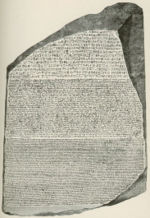
Archibald Constable, an apprentice bookseller, was involved in the publication to varying degrees from 1788 and after Macfarquhar's death in 1793. Constable, after a stretch of work in his own publishing firm, went on in 1812 to acquire the Britannica from its trustees. From 1812 to 1826 his firm published the Britannica. The fourth, fifth and sixth editions, and the supplement to them, included works by a number of highly regarded Scottish and English authors and scientists: William Hazlitt, John Stuart Mill, Thomas Malthus, David Ricardo, Walter Scott, and Thomas Young, whose article on Egypt included the translation of the hieroglyphics on the Rosetta Stone.
In the late 1820s, due to financial problems at Constable, the rights to the Britannica were acquired by the Edinburgh publishing firm of A & C Black. They published the seventh and eighth editions, and included new chapters, such as "Architecture" by William Hosking. The landmark ninth edition, often called 'the Scholar's Edition', was published from 1875 to 1889. The ninth edition included numerous in-depth scholarly articles by pre-eminent authors, and therefore is considered by some to mark the high point in the history of English-language encyclopedias.
A & C Black moved to London in 1895. The Britannica later became associated with The Times newspaper, and was sold in 1901. The 10th edition—of 11 volumes, including map and index volumes—was issued in effect as a large supplement to the ninth edition. The American Horace Everett Hooper was the publisher from 1897 to 1922. From 1909, and for the 11th edition, the publication became associated with the University of Cambridge, England.
The substantially rewritten 11th edition of 1910–11 is a classic edition of the Encyclopædia Britannica. The role of the encyclopedia changed substantially in the early 20th century, and the 11th edition of Encyclopædia Britannica (1911) reflected this. One key change was a shift from attempting to encompass the cutting edge of human knowledge, a goal made impractical by—among other things—the rapid expansion of scientific knowledge around the turn of the century. A second change reflected a changing readership. As the use of the encyclopedia as a general reference grew, readers expected shorter, more readable articles, rather than the primary authoritative scholarship that had defined earlier versions. These articles, intended to gain a wider audience and increased sales, were shorter, but still thorough in their own frame.
Sometimes called the 1911 Encyclopædia Britannica, this edition is available in the public domain. The 11th edition was the first to be published substantially at one time, instead of volume by volume. The complete text is freely available online.
The trademark and publication rights were sold after the 11th edition to Sears Roebuck and it moved to Chicago. The 12th and 13th editions each took the form of a three-volume supplement (an update), intended for used in conjunction with the 11th edition. The 14th edition of 1929 marked a major shift, with fewer volumes and shorter articles, meant to be more accessible as a reference to a wider range of readers. However, the 14th edition was criticised by priest-turned-atheist Joseph McCabe, who claimed that it had been stripped of unfavourable content about the Catholic Church.
Sears Roebuck offered the rights to the Britannica as a gift to the University of Chicago in 1941. William Benton was the publisher from 1943 to his death in 1973, followed by his widow Helen Hemingway Benton until her own death in 1974. In January 1996, the Britannica was purchased by billionaire Swiss financier Jacob Safra. In October 2002, Esquire editor A. J. Jacobs set out to read all 33,000 pages of the Britannica. He chronicled this quest for knowledge in the 2004 book The Know-It-All.
CD-ROM edition and Britannica Online
In the 1980s, Microsoft approached Britannica Inc. to collaborate on a CD-ROM encyclopedia. Britannica Inc., feeling that they had control of the market and showing strong profits (sales of the complete Britannica were priced between $1,500 and $2,200), turned Microsoft down. Britannica Inc.'s senior management viewed their product as a luxury brand with an impeccable reputation handed down from generation to generation. They did not believe that a CD-ROM could adequately compete or supplement their business. In turn, Microsoft used content from Funk & Wagnalls Standard Encyclopedia to create what is now known as Encarta.
In 1990, the Britannica's sales reached all-time high of $650 million. But Encarta, released in 1993, became a software staple with almost every computer purchase and the Britannica's market share plummeted. Britannica Inc. countered by offering a CD-ROM version of their product, although a CD-ROM could not generate the $500 to $600 in sales commissions that the print version did. Britannica Inc. decided on charging $995 for customers looking to purchase only the CD-ROM, while bundling a free disc with the print version. Britannica Inc. hoped that including the CD-ROM would entice buyers to stay with the brand.
In 1994 an online version was launched, with subscriptions for sale for $2,000. By 1996, the cost of the CD-ROM had dropped to $200. Sales had plummeted to $325 million—about half of their 1990 levels. Only 55,000 hard copy versions were sold in 1994, compared with 117,000 in 1990, and sales later fell to 20,000. Facing financial pressure, Britannica Inc. was purchased by Swiss financier Jacob Safra in 1996 for $135 million, a fraction of its book value. Since then Safra has introduced massive price-cutting measures in an effort to compete with Encarta, even offering the entire reference free of charge for a time (around 18 months, from October 1999 to March 2001) on the Internet.
Currently, Britannica co-operates with Taiwan companies (遠流/智慧藏學習科技公司) to provide a Traditional Chinese-English bilingual version encyclopedia on internet according to the 2002 edition. It is the first bilingual product of Britannica.
Former editor-in-chief Robert McHenry believes that Britannica failed to exploit its early advantages in the market for electronic encyclopedias. Britannica had, for example, published the second multimedia encyclopedia titled Compton's MultiMedia Encyclopedia as early as 1989 (the first one being the Academic American Encyclopedia published by Grolier), but did not launch Britannica CD until 1994, one year after Microsoft launched their Encarta encyclopedia. McHenry believes these failures were due to a reluctance among senior management to fully embrace the new technology, caused largely by the overriding influence of the sales staff and management. The sales personnel earned commissions from door-to-door selling of the print encyclopedias, which McHenry believes led to decisions about the distribution and pricing of the electronic products being driven by the desires of the sales personnel, rather than market conditions and customer expectations.
Competition
Nowadays, one of the biggest challenges to the Britannica is the ease with which people can find information online. Many people simply prefer to find information with the help of a search engine, such as Google, Yahoo! or MSN Search. While the information available on the Internet is typically not as structured and critically edited as that contained in Britannica, this is partly compensated for by the convenience and the sheer volume of information typically available on any subject. Advanced searching algorithms, such as page rank algorithm used by Google, also assist an experienced user to quickly narrow down an investigation to relevant pages.
Online alternatives to the Britannica include Wikipedia, a Web-based free-content encyclopedia. Wikipedia is free to use; alternatively, the print and electronic versions of Britannica are available at libraries for checkout (either directly or through ILL) and can be accessed from home using some library web sites.
Substantive comparisons between the Britannica and Wikipedia are hard to draw. The journal Nature reported on December 14, 2005 that of the 42 science articles it reviewed, there were 162 mistakes in Wikipedia versus 123 for Britannica. Britannica Inc. attacked Nature's study as flawed and misleading and demanded a retraction. It mentioned that two of the articles in the study were actually from a Britannica year book, and not the encyclopedia. Another two were from Compton's Encyclopedia (called the Britannica Student Encyclopedia on the company's web site) and yet another reviewer comment regards an unknown publication. Encyclopædia Britannica went on to mention that some of the articles presented to reviewers were combinations of several articles. Britannica continued by citing several facts that were classified as errors by Nature but were not incorrect (e.g., the spelling of Crotona as Crotone). Nature defended its story and declined to retract it, stating that as it was comparing Wikipedia with the web version of Britannica, it used whatever relevant material was available on Britannica's website.
As for the CD-ROM and DVD-ROM versions of Britannica, its biggest competitor is Encarta. Both are in the same price range, with the 2007 Encyclopædia Britannica Ultimate CD or DVD costing US$50 and the Microsoft Encarta Premium 2007 DVD costing US$45. Britannica contains 100,000 articles, Merriam-Webster's Dictionary and Thesaurus (U.S. only), as well having Primary and Seconday School editions. Encarta contains 64,000 articles, a U.S. and U.K. dictionary, and a youth edition. Britannica has been criticised for only catering for United States audiences, because United Kingdom-related articles are less often updated, maps of the United States are more detailed than the rest of the World, and due to its lack of a U.K. dictionary. However, Britannica is still regarded as more in depth than Encarta.
Comparing Encyclopædia Britannica with other print encyclopedias also provides a mixed picture. Kenneth Kister's Kister's Best Encyclopedias, 2nd edition (1994) compared the accuracy of several encyclopedias. Britannica, although more accurate than many, was ranked lower than Encyclopedia Americana, World Book Encyclopedia, and Compton's Encyclopedia, all of which received perfect scores. Another area in which Britannica lags when compared with other print reference works is currency. Kister's ranked Britannica lower in this respect than the same three aforementioned works, as well.
Current version
Encyclopædia Britannica Inc. now owns a trademark on the word "Britannica." The current version of Britannica was written by over 4,000 contributors, including noted scholars such as Milton Friedman, Michael DeBakey and Carl Sagan. Under the influence of the director of planning, Mortimer Adler, the 15th edition, first published in 1974 and frequently reissued since, was published not as one alphabetical sequence of volumes as previously but in three parts that covered topics in different degrees of depth: a one-volume Propædia that provides a structured hierarchy to all the information in the set, a 12-volume Micropædia which contains short articles (most of them from one to five paragraphs), and a 17-volume Macropædia for longer articles, which range from a few pages to over three hundred pages. The Micropædia provides cross-references from articles to more extended treatment in the Macropædia or to other related Micropædia coverage. Macropædia articles deal with topics such as countries, individual sciences and surveys of broad divisions of culture. They contain many subsections which would be covered by individual articles in most encyclopedias. Britannica's intention is to provide systematic surveys of knowledge and to put detail into context. A two-volume index was added in 1985. The print edition continues to be produced, with each version being an updated printing of the 15th edition. Forty-six percent of the content of the encyclopedia has been revised within the last three years. A newly revised print set was issued in 2005.
The Britannica Ultimate Reference Suite 2006 DVD contains over 55 million words and just over 100,000 articles. This includes 73,645 regular Encyclopædia Britannica articles, with the remainder drawn from the Britannica Student Encyclopædia, the Britannica Elementary Encyclopædia and the Britannica Book of the Year (1993–2004), plus a small number of "classic" articles from early editions of the encyclopaedia. The package also includes a range of supplementary content including maps, videos, sound clips, animations and web links. It also offers study tools and dictionary and thesaurus entries from Merriam-Webster.
The online version has more than 120,000 articles and is updated daily. It also has daily features, updates and links to news articles from New York Times and the BBC. Subscriptions cost $69.95 per year in the United States and £39.99 per year in the United Kingdom. Weekly and monthly plans are also available. Special subscription plans are offered to schools, colleges and libraries and this is an important part of Britannica's business.
Britannica uses a hybrid of British and American English, for example colour (not colour), centre (not centre), encyclopaedia (not encyclopedia), but civilize (not civilise) and defense (not defence).
Editors
Dale Hoiberg, a sinologist, is the publication's current editor-in-chief. Among his predecessors were Hugh Chisholm (1903–13, 1920–24), James Louis Garvin (1926–32), Franklin Henry Hooper (1932–38), Walter Yust (1938–60), Harry Ashmore (1960–63), Warren E. Preece (1964–75), and Robert McHenry (1992–97). Ted Pappas is the current executive editor. Earlier holders of that position were John V. Dodge (1950–64) and Philip W. Goetz. Don Yannias, former CEO of the company when it was in financial difficulties, serves on Britannica's Board of Directors.
Among the members of the editorial board are such notable figures as Nobel laureate in Physics Murray Gell-Mann, biologist and Nobel laureate David Baltimore, cognitive scientist Donald Norman, economist Amartya Sen, philosopher Thomas Nagel, former Ecuadorian president Rosalía Arteaga and Pritzker Architecture Prize winner Zaha Hadid.
Versions
There are several abbreviated Britannica encyclopedias. The single-volume Britannica Concise Encyclopædia has 28,000 articles; Compton's by Britannica, which incorporates the former Compton's Encyclopedia, consists of 26 volumes with a total of 11,000 pages, and is aimed at secondary school age children; My First Britannica is aimed at 6 to 12 year olds; and the Britannica Discovery Library is targeted at pre-school children. Since 1938 Britannica has published annually a Book of the Year chronicling the past year's events, also available online back to the 1994 edition (covering the events of 1993). Britannica Inc. also publishes a number of specialist reference works.
Edition history
| Edition | Published | Size | Editor(s) |
|---|---|---|---|
| 1st | 1768–71 | 3 vol. | William Smellie |
| 2nd | 1777–84 | 10 vol. | James Tytler |
| 3rd | 1788–97, 1801 sup. | 18 vol. + 2 sup. | Colin Macfarquhar and George Gleig |
| 4th | 1801–09 | 20 vol. | James Millar |
| 5th | 1815 | 20 vol. | James Millar and Thomas Bonar |
| 6th | 1820–23, 1815–24 sup. | 20 vol. + 6 sup. 1 | Charles Maclaren and Macvey Napier |
| 7th | 1830–42 | 21 vol. | Macvey Napier |
| 8th | 1853–60 | 22 vol. 2 | Thomas Stewart Traill |
| 9th | 1875–89 | 25 vol. 3 | Thomas Spencer Baynes (to 1880, then W. Robertson Smith) |
| 10th | 1902–03 | 9th ed. + 11 sup. 4 | Sir Donald Mackenzie Wallace, Hugh Chisholm, and Arthur T. Hadley with Franklin H. Hooper |
| 11th | 1910–11 | 29 vol. | Hugh Chisholm |
| 12th | 1921–22 | 11th ed. + 3 sup. 5 | Hugh Chisholm |
| 13th | 1926 | 11th ed. + 3 sup. 6 | James Louis Garvin |
| 14th | 1929–73 | 24 vol. 7 | James Louis Garvin with Franklin Henry Hooper |
| 15th | 1974–84 | 30 vol. 8 | Mortimer J. Adler, William Benton, and Charles E. Swanson |
| 1985– | 32 vol. 9 |
Edition notes
1Supplement to the fourth, fifth, and sixth editions of the Encyclopaedia Britannica. With preliminary dissertations on the history of the sciences. 2 8th to 14th editions included a separate index volume. 3 9th ed. featured articles by notables of the day, such as James Maxwell on electricity and magnetism, and William Thomson (who became Lord Kelvin) on heat. 4 10th ed. included a maps volume and a cumulative index volume for the 9th and 10th edition volumes: the new volumes, constituting, in combination with the existing volumes of the 9th ed., the 10th ed. ... and also supplying a new, distinctive, and independent library of reference dealing with recent events and developments 5 Vols. 30-32 ... the New volumes constituting, in combination with the twenty-nine volumes of the eleventh edition, the twelfth edition 6 This supplement replaced the previous supplement: The three new supplementary volumes constituting, with the volumes of the latest standard edition, the thirteenth edition. 7 This edition was the first to be kept up to date by continual (usually annual) revision. 8 The 15th edition (introduced as "Britannica 3") was published as multiple sets: the 10-volume Micropædia (containing short articles and served as an index), the 19-volume Macropædia, plus the Propædia (see text). 9 In 1985 the system was modified by removing the index function from the Micropædia and adding a separate two-volume index; the Macropædia articles were further consolidated into fewer, larger ones (for example, the previously separate articles about the 50 U.S. states were all included into the "United States of America" article), with some medium-length articles moved to the Micropædia. The first CD-ROM edition was issued in 1994. At that time also an online version was offered for paid subscription. In 1999 this was offered for free, and no revised print versions appeared. The experiment was ended, however, in 2001 and a new printed set was issued in 2002. |
